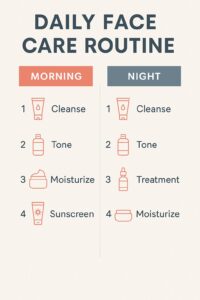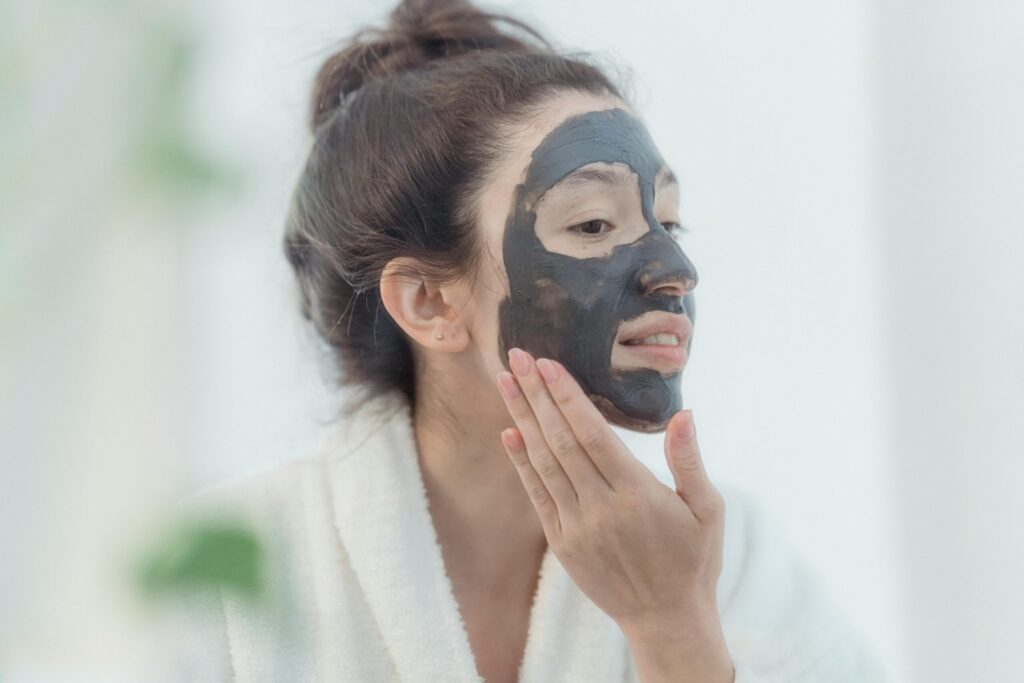
Discover how to achieve radiant skin with a face care routine at home using natural, effective solutions. This guide helps you address dryness, breakouts, or dullness by identifying your skin type, choosing plant-based products, and building personalized routines. Embrace sustainable beauty with practical tips and step-by-step advice to make your skin glow naturally from the comfort of home.
What Is Natural Skin Care?
Natural skin care refers to products and routines that prioritize ingredients derived from plants, minerals, and other naturally occurring substances.
These products are typically free from synthetic chemicals, artificial fragrances, parabens, sulfates, and other potentially harmful additives.
However, the term “natural” isn’t strictly regulated, so it’s crucial to read ingredient labels carefully and understand what you’re applying to your skin.
The philosophy of natural skincare is rooted in simplicity, sustainability, and authenticity.
It harnesses the power of nature—think herbs, flowers, seeds, oils, clays, and fruits—to nourish, protect, and rejuvenate your skin.
By focusing on minimally processed ingredients, natural skincare retains the nutrient density of these elements, delivering vitamins, antioxidants, and minerals directly to your skin.
Key Features of Natural Skincare
- Plant-Based Ingredients: Sourced from botanicals like aloe vera, chamomile, and tea tree oil.
- Free from Harmful Additives: No synthetic dyes, parabens, sulfates, or artificial fragrances.
- Eco-Conscious: Often cruelty-free, sustainably sourced, and packaged in environmentally friendly materials.
- Minimal Processing: Retains the natural potency of ingredients for maximum efficacy.
By understanding the principles of natural skincare, you can make informed choices and create routines that align with your skin’s needs and your values.
Why Choose Natural Skincare? (Top Benefits)
Switching to natural skincare offers a multitude of benefits for your skin, overall health, and the environment. Here’s why it’s worth making the transition:
Gentler on Skin:
Natural products are ideal for sensitive or reactive skin, as they avoid irritants like synthetic fragrances and harsh chemicals.
Free from Toxins:
By eliminating parabens, sulfates, and artificial additives, natural skincare reduces the risk of long-term skin damage or systemic absorption of harmful substances.
Nutrient-Rich Formulas:
Ingredients like rosehip oil, green tea, and aloe vera are packed with vitamins (A, C, E), antioxidants, and minerals that nourish and repair your skin.
Eco-Friendly and Ethical:
Many natural skincare brands prioritize sustainable sourcing, biodegradable packaging, and cruelty-free practices, aligning with environmentally conscious values.
Holistic Wellness:
Natural skincare encourages a mindful approach to beauty, promoting overall well-being through clean, non-toxic products.
Customizable and Empowering:
With natural ingredients, you can experiment with DIY recipes or select products tailored to your skin’s unique needs, giving you control over your routine.
Long-Term Skin Health:
Avoiding harsh chemicals helps maintain your skin’s natural barrier, reducing the risk of premature aging, irritation, or sensitivity.
By choosing natural skincare, you’re investing in your skin’s health and supporting a sustainable, ethical approach to beauty.
How to Know Your Skin Type
Before building your face care routine at home, you must understand your skin type. Your skin’s needs can vary due to genetics, hormones, diet, stress, and environmental factors like weather.
Identifying your skin type ensures you choose products and routines that address your specific concerns.
Common Skin Types
- Oily Skin: Characterized by a shiny appearance, enlarged pores, and frequent breakouts, especially in the T-zone (forehead, nose, chin).
- Dry Skin: Feels tight, flaky, or rough, often with visible patches or discomfort after cleansing.
- Combination Skin: A mix of oily (typically T-zone) and dry or normal areas (cheeks and jawline).
- Acne-Prone Skin: Prone to frequent breakouts, clogged pores, and sensitivity to certain ingredients.
- Sensitive Skin: Easily irritated, with redness, itching, or burning sensations triggered by products, weather, or stress.
- Mature or Darker Skin: May experience hyperpigmentation, uneven texture, or signs of aging like fine lines and reduced elasticity.
How to Determine Your Skin Type
- Cleanse and Wait: Wash your face with a gentle cleanser, pat dry, and wait 2–3 hours without applying products. Observe how your skin feels and looks:
- Oily: Shiny, greasy, especially in the T-zone.
- Dry: Tight, flaky, or rough.
- Combination: Oily in some areas, dry or normal in others.
- Sensitive: Prone to redness or irritation after cleansing.
- Check Pore Size: Larger pores often indicate oily skin, while smaller pores are common in dry or normal skin.
- Monitor Breakouts: Frequent acne may suggest oily or acne-prone skin.
- Consider External Factors: Hormones, climate, and lifestyle can temporarily alter your skin type.
By pinpointing your skin type, you can select the right products and routines to achieve optimal results.
Natural Skincare Routines by Skin Type
Tailoring your face care routine to your skin type is essential for addressing specific concerns like oiliness, dryness, or sensitivity. Below are customized routines featuring natural ingredients for each skin type, inspired by recommendations from Mayo Clinic.
Oily Skin
- Cleanser: Use a foaming cleanser – like: CareVe foaming cleanser – with tea tree oil or witch hazel to control oil without stripping the skin. Tea tree oil cleansers are a staple in the best routine for oily skin
- Moisturizer: Opt for lightweight, non-comedogenic options like aloe vera gel or oil-free creams.
- Weekly Treatments: Apply clay masks (kaolin or bentonite) to absorb excess oil and detoxify pores.
- Key Ingredients: Niacinamide (to regulate sebum), green tea (antioxidant), and willow bark-derived salicylic acid (to unclog pores).
Dry Skin
- Cleanser: Choose creamy, hydrating cleansers with aloe vera, glycerin, or chamomile- we prefer Vanicream Gentle Cleanser.
- Moisturizer: Use rich formulas with shea butter, jojoba oil, or avocado oil to lock in moisture.
- Serum: Incorporate oil-based serums with rosehip or argan oil for added hydration.
- Weekly Treatments: Hydrating masks with honey, cucumber, or oatmeal to soothe and nourish.
Oily Skin vs. Dry Skin Routine: Comparison Table
|
Step |
Oily Skin Routine |
Dry Skin Routine |
|
Cleanser |
Foaming cleanser with tea tree oil or salicylic acid (e.g., CeraVe Foaming Cleanser). |
Creamy, hydrating cleanser with glycerin or ceramides (e.g., Vanicream Gentle Cleanser). |
|
Toner |
Alcohol-free, astringent toner (witch hazel or niacinamide). |
Hydrating toner (rose water or hyaluronic acid). |
|
Exfoliation |
2–3x/week: BHA (salicylic acid) or clay masks. |
1–2x/week: Gentle AHAs (lactic acid) or enzyme exfoliants. |
|
Serum |
Oil-free, mattifying (niacinamide or zinc). |
Hydrating (hyaluronic acid or squalane). |
|
Moisturizer |
Lightweight, gel-based (aloe vera or sebum-regulating creams). |
Rich creams (shea butter, ceramides, or jojoba oil). |
|
Mask (Weekly) |
Clay or charcoal masks to detoxify. |
Hydrating masks (honey, oatmeal, or avocado). |
|
Sunscreen |
Oil-free, matte finish (mineral SPF with zinc oxide). |
Creamy, moisturizing SPF (titanium dioxide-based). |
|
Key Ingredients |
Tea tree oil, niacinamide, green tea. |
Hyaluronic acid, rosehip oil, ceramides. |
|
Avoid |
Heavy oils, silicones, alcohol-based products. |
Harsh sulfates, drying alcohols, fragrances. |
Key Takeaways:
- Oily Skin: Focus on oil control, pore refinement, and lightweight hydration.
- Dry Skin: Prioritize moisture retention, barrier repair, and gentle exfoliation.
Combination Skin
- Cleanser: Use a balancing cleanser that cleanses without over-drying, such as one with chamomile or green tea.
- Moisturizer: Apply lightweight, non-comedogenic creams to hydrate without clogging pores.
- Treatments: Spot-treat oily areas with clay masks and hydrate dry patches with aloe or hyaluronic acid.
- Key Ingredients: Rose water (balancing), niacinamide (oil control), and calendula (soothing). For a detailed combination skin routine, explore our step-by-step guide.
For a detailed combination skin routine, explore our step-by-step guide.
Acne-Prone Skin
- Cleanser: Use tea tree oil or willow bark extract cleansers to combat bacteria and unclog pores.
- Moisturizer: Choose calming, non-comedogenic options with chamomile or calendula.
- Exfoliant: Gentle fruit enzyme scrubs (papaya or pineapple) to remove dead skin without irritation.
- Serum: Zinc-rich or probiotic-based serums to reduce inflammation and support skin repair.
Sensitive Skin
- Cleanser: Opt for micellar water or gentle cream cleansers with soothing ingredients like aloe vera or oatmeal.
- Moisturizer: Use fragrance-free, hypoallergenic creams with chamomile or calendula.
- Avoid: Harsh exfoliants, fragrances, sulfates, and alcohol-based products.
- Weekly Treatments: Calming masks with cucumber or aloe to reduce redness.
- Fragrance-free products are essential for sensitive skin care
Mature or Darker Skin Tones
- Cleanser: Gentle, hydrating cleansers with rose water or aloe vera.
- Exfoliation: Use fruit enzyme exfoliants (papaya or pineapple) to avoid irritation.
- Targeted Treatments: Licorice root extract or vitamin C serums to address hyperpigmentation and uneven tone.
- Sunscreen: Apply broad-spectrum, mineral-based SPF (zinc oxide or titanium dioxide) to protect against UV damage.
- Licorice root extract is a hero ingredient in mature skin routines
By customizing your routine to your skin type, you’ll address specific concerns while promoting long-term skin health.
Morning & Night Skincare Routines (Step-by-Step)
A consistent morning and night routine is the foundation of glowing skin. Here’s a step-by-step guide to building an effective face care routine at home using natural products, as recommended by Harvard Health.
Morning Routine
- Cleanse: Start with a gentle cleanser suited to your skin type to remove overnight buildup.
- Exfoliate (2–3 Times a Week): Use natural alpha hydroxy acids (AHAs) like lactic acid from yogurt or fruit enzymes to slough off dead skin.
- Tone: Apply a toner like rose water or chamomile to rebalance your skin’s pH and prep for hydration.
- Serum (Optional): Use a lightweight serum with vitamin C, green tea, or niacinamide for an antioxidant boost.
- Moisturize: Apply a lightweight moisturizer to lock in hydration without feeling heavy.
- Protect: Finish with a broad-spectrum sunscreen (SPF 30 or higher), preferably mineral-based with zinc oxide or titanium dioxide.
Night Routine
- Cleanse: Double-cleanse if you wear makeup or sunscreen, starting with an oil-based cleanser (like jojoba or almond oil) followed by a water-based cleanser.
- Tone: Use a calming toner like rose water or witch hazel to restore pH balance.
- Eye Cream: Apply a nourishing eye cream with hyaluronic acid, peptides, or caffeine to address puffiness or dark circles.
- Serum (Optional): Use a reparative serum with niacinamide, vitamin E, or bakuchiol (a natural retinol alternative) for overnight repair.
- Moisturize: Apply a richer night cream with shea butter, rosehip oil, or argan oil to nourish and repair.
Note: At night, focus on cleansing, toning, and nourishing with richer products. For a comprehensive guide to maximizing your evening skincare, explore the best night skincare regimen.
Visual Guide: AM/PM Routine at a Glance
Follow this infographic to simplify your daily routine:

Consistency is key—stick to your routine daily to see noticeable improvements in your skin’s texture and radiance.
Weekly Treatments: Detox Mask & More

Weekly treatments like detox masks, exfoliation, and facial steaming can elevate your face care routine by addressing deeper concerns like clogged pores, dullness, or dehydration, as supported by insights from Medical News Today.
Detox Masks
Detox masks draw out impurities, balance oil production, and refresh your complexion. Apply them 1–2 times per week after cleansing.
Best Ingredients for Detox Masks:
A detox mask for glowing skin should include ingredients like turmeric, clay, and aloe vera, as follows:
- Clays: Bentonite or kaolin to absorb oil and detoxify pores.
- Activated Charcoal: Pulls out impurities and excess oil.
- Botanicals: Chamomile, calendula, or tea tree for soothing and antibacterial benefits.
- Antioxidants: Green tea or turmeric to fight free radicals and inflammation.
- Hydrators: Honey, aloe vera, or glycerin to prevent over-drying.
How to Use:
- Cleanse your face thoroughly.
- Apply a thin, even layer of the mask, avoiding the eye area.
- Leave on for 10–15 minutes (or as directed).
- Rinse with lukewarm water and follow with toner and moisturizer.
Other Weekly Treatments
- Exfoliation: Use gentle exfoliants like fine oats, fruit enzymes, or rice powder 1–3 times per week to remove dead skin cells.
- Sheet Masks: Hydrating or calming sheet masks with aloe, cucumber, or rose water for an extra boost of moisture.
- Facial Steaming: Steam your face with herbs like lavender, rosemary, or chamomile to open pores, promote circulation, and enhance product absorption. Do this 1–2 times per week for 5–10 minutes.
These homemade face care tips offer affordable, effective alternatives to commercial treatments.
Incorporating these treatments into your routine will keep your skin refreshed and radiant.
Seasonal Skincare Adjustments
Your skin’s needs change with the seasons due to shifts in temperature, humidity, and sun exposure. Adapting your face care routine ensures your skin stays balanced year-round.
-
Summer
:- Use lightweight, oil-free moisturizers and gel-based cleansers to combat humidity and sweat.
- Apply mattifying sunscreen (SPF 30+) to protect against UV rays.
- Cleanse twice daily to remove excess oil and environmental pollutants.
-
Winter
:- Switch to richer moisturizers with shea butter, avocado oil, or ceramides to combat dryness.
- Avoid hot water, which strips natural oils, and use lukewarm water instead.
- Incorporate facial oils (like rosehip or argan) for extra hydration.
-
Spring
:- Focus on detoxing with clay masks and exfoliation to refresh skin after winter.
- Use brightening serums with vitamin C or licorice root to address dullness.
-
Autumn
:- Repair summer sun damage with antioxidant-rich serums and hydrating masks.
- Prep for drier air by incorporating heavier moisturizers and humectants like hyaluronic acid.
By adjusting your routine seasonally, you’ll keep your skin healthy and resilient no matter the weather.
Natural Ingredients to Include (and Avoid)
Choosing the right ingredients is critical for an effective face care routine at home. Here’s a breakdown of the best natural ingredients to include and those to avoid..
Best Natural Ingredients
- Hydrators: Aloe vera, hyaluronic acid, rose water, and glycerin to lock in moisture.
- Brighteners: Vitamin C, licorice root extract, and turmeric to even skin tone and reduce hyperpigmentation.
- Soothers: Oatmeal, chamomile, and calendula to calm irritation and redness.
- Anti-Aging: Bakuchiol (natural retinol alternative), rosehip oil, and green tea to promote collagen and fight free radicals.
- Exfoliants: Fruit enzymes (papaya, pineapple) and rice powder for gentle exfoliation.
- Antibacterials: Tea tree oil and willow bark extract to combat acne-causing bacteria.
Ingredients to Avoid
- Artificial Fragrances: Can cause irritation and allergic reactions.
- Parabens and Sulfates: Linked to skin irritation and potential long-term health concerns.
- Synthetic Colorants: Unnecessary and potentially irritating.
- Harsh Alcohols: SD alcohol or denatured alcohol can strip the skin’s natural barrier.
When shopping, always check ingredient lists and opt for products with transparent, clean formulations.
Skincare Routine for Your 30s: Best Practices & Tips
As you age, your skin’s needs evolve. In your 30s and beyond, focus on prevention, hydration, and repair to maintain a youthful complexion.
- Consistency: Stick to your morning and night routines to build cumulative benefits over time.
- Hydration: As skin naturally becomes drier with age, use richer moisturizers and facial oils to lock in moisture.
- Sun Protection: Apply broad-spectrum SPF 30+ daily to prevent premature aging, hyperpigmentation, and collagen breakdown.
- Eye Care: Use eye creams with peptides, caffeine, or hyaluronic acid to address fine lines, puffiness, and dark circles.
- Anti-Aging Treatments: Incorporate weekly masks or serums with bakuchiol, rosehip oil, or vitamin C to boost collagen and elasticity.
- Lifestyle Factors: Support your skin with a balanced diet, adequate hydration, stress management, and 7–8 hours of sleep nightly.
By prioritizing these practices, you’ll help your skin age gracefully and maintain its natural glow.
Conclusion & Resources
Your skin is as unique as you are, and a personalized face care routine at home can unlock its full potential. By embracing natural skincare, you’re choosing gentle, sustainable, and effective solutions that nourish your skin while aligning with your values.
From identifying your skin type to incorporating weekly treatments and seasonal adjustments, this guide provides the tools to achieve glowing, healthy skin from the comfort of home.
To go even deeper into the basics, don’t miss our guide on what’s essential in a skincare routine.
Free Resource:
Want a printable version? Download our Face Care Routine Checklist PDF to streamline your routine.
Explore More
Further Reading:
Natural Skin Care & Homemade Beauty Tips
Shop the Routine
Cleansers:
CeraVe Renewing Salicylic Acid Cleanser
Vanicream Gentle Facial Cleanser
Toners:
Thayers Alcohol-Free Rose Petal Toner
Moisturizers:
Neutrogena Hydro Boost Water Gel
Serums:
The Ordinary Hyaluronic Acid Serum
Masks:
Yes to Coconut Ultra Hydrating Paper Mask
Sunscreens:
EltaMD UV Clear Broad-Spectrum SPF 46
Disclosure: This article contains affiliate links. We earn a small commission if you make a purchase at no extra cost to you.
Face Care FAQs
What is the best skincare routine at home?
A complete routine includes cleansing, toning, treating (serums or targeted treatments), moisturizing, and protecting with sunscreen in the morning. At night, focus on cleansing, toning, and nourishing with richer products.
What are the 5 basics of skincare?
- Cleanser
- Toner
- Moisturizer
- Exfoliant (used 1–3 times per week)
- Sunscreen (morning only)
How often should I exfoliate?
Exfoliate 1–3 times per week, depending on your skin type and sensitivity. Over-exfoliation can cause irritation, so start slowly and monitor your skin’s response.
What’s the best skincare for men?
Men’s skincare follows the same principles: cleanse, exfoliate, moisturize, and protect with sunscreen. Opt for natural, fragrance-free products tailored to your skin type (oily, dry, etc.).
Can I make my own skincare products?
Yes! DIY recipes using yogurt, honey, aloe vera, oatmeal, or avocado are simple and effective. Always use clean tools, store products properly, and patch-test to avoid irritation.
Is natural skincare safe during pregnancy?
Most natural ingredients are safe, but avoid retinoids, high doses of essential oils (like rosemary or clary sage), and untested DIY blends. Consult a healthcare provider for personalized advice.
How can I address hyperpigmentation naturally?
Use ingredients like vitamin C, licorice root extract, or niacinamide to brighten skin and reduce dark spots. Consistent sunscreen use is critical to prevent worsening pigmentation.






